8 Wildflowers That Grow in Massachusetts (Identification Guide With Pictures)
-

- Last updated:
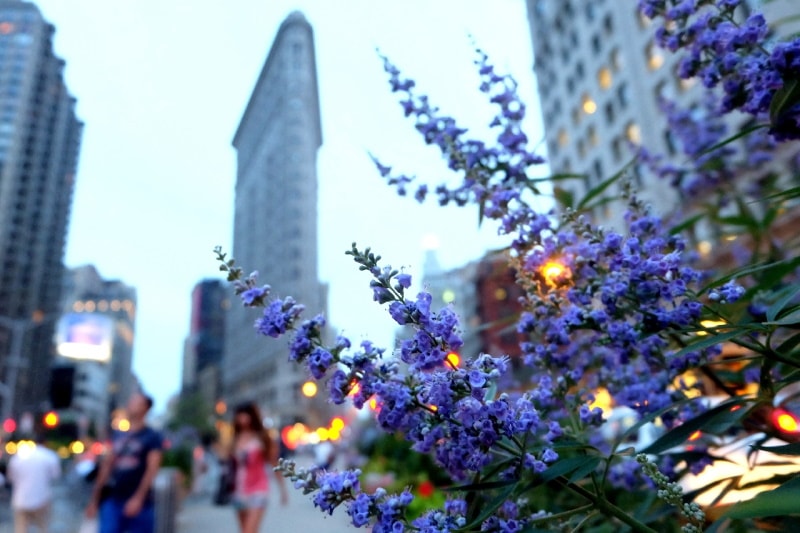
Massachusetts encounters all four seasons during the year. As a result, the state experiences abrupt weather changes that make it harder for flowering plants to survive. For instance, temperatures can go as high as 100 degrees in the summer and as low as -17 degrees during winter. Wildfires are also common, with 816 fires in 2022 affecting close to 1,300 acres.
However, native plants have adapted to the ever-shifting weather patterns. Indeed, the state is home to hundreds of different species of wildflowers that have survived the vagaries of weather over the years. Below, we examine eight different species of wildflowers that grow in Massachusetts.

The 8 Wildflowers That Grow in Massachusetts
1. Blue Vervain

| Scientific Name: | Verbena hastata |
| Flower Color: | purple, violet, or light lavender |
| Hardiness Zone: | 3 to 9 |
| Bloom Time: | Summer through fall |
Blue vervain is a species of plant native to North America. It is also known as blue verbena and blooms purple, violet, or light lavender flowers in the summer through fall. These grow on spikes resembling large branched candlestick holders.
A mature blue verbena grows up to three feet tall and extends to four feet when you account for the flowers. The rough, hairy stems branch above and support lanceolate green leaves with toothed margins.
Apart from their lavishing looks, blue vervain flowers are butterfly magnets. Today, they are also used for medicinal purposes in applications such as easing nervous tensions, reducing anxiety, and improving digestion.
Habitat
Blue vervain naturally grows in plains, wet soils, foothills, ditches, and shores. It thrives in average-to-wet conditions and can tolerate standing water. Although it performs best in acidic soils, it will survive in soils with any pH level.
You can plant blue vervain in the garden or pots and containers, provided you remember to water it more often in the latter. It will certainly look good as a thriller in a ‘spiller-thriller-filler.’ But it is also large enough (three feet wide) to sit in the container alone.
2. White Yarrow
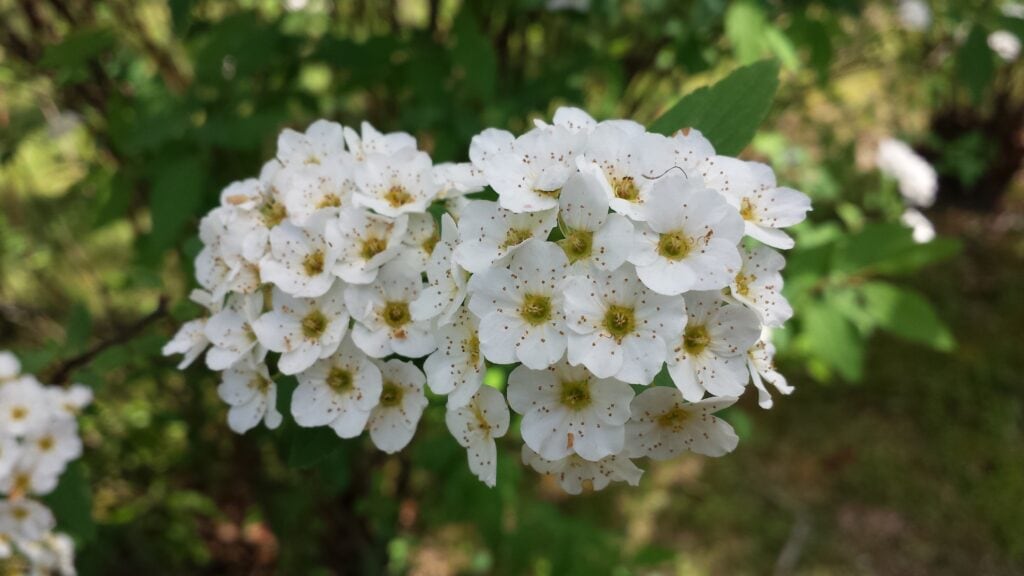
| Scientific Name: | Achillea millefolium |
| Flower Color: | Creamy-white |
| Hardiness Zone: | 3 to 9 |
| Bloom Time: | Early to late summer |
White yarrow features tall stems with green foliage that resembles ferns. They can grow 2–3 feet tall with a spread of 1–3 feet.
The creamy-white flowers grow directly above the leaves in huge, flat clusters of 20–25 and bloom for weeks, allowing you to enjoy their beauty for longer. Moreover, you can also extend the bloom season through deadheading.
Both flowers and foliage are attractive. That makes white yarrow a great choice for cut flowers in bouquets and floral arrangements. Their attractive looks combined with the earthy and herby scent also make them butterfly magnets.
Habitat
White yarrow occurs naturally in roadsides, disturbed areas, open forests, and grasslands. It does well in well-drained soils and can tolerate dry areas. However, moist soil could make it floppy or leggy.
The wildflower thrives best in average to dry moisture and sunny conditions. It is resistant to heat and drought and can survive in less-than-perfect conditions.
White yarrow can look great in your garden, mixed border, meadows, and prairies. But you should take caution if you have pets around since it is toxic to cats, dogs, and horses.
3. Oxeye Daisy
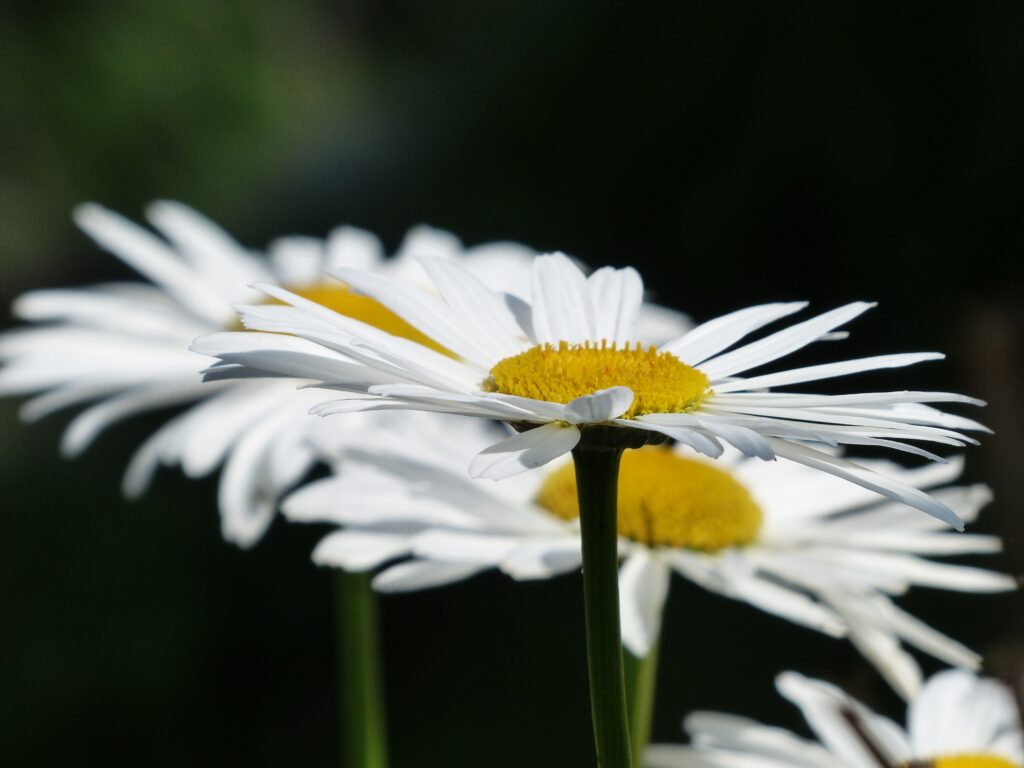
| Scientific Name: | Leucanthemum vulgare |
| Flower Color: | White with yellow center disc |
| Hardiness Zone: | 3 to 8 |
| Bloom Time: | Spring to summer |
Oxeye daisies will add a cheerful and mystical look to any landscape. The wildflower originated in Europe and is famed for its aggressive spreading thanks to its seeds and underground rhizomes. Plant it among other plants and it will easily colonize the ecosystem.
Although it can self-fertilize, the oxeye daisy also gets help from insects, so you should expect to see pollinators such as butterflies, moths, beetles, and bees swarming to the white-petaled flowers.
Interestingly, the simple, alternate leaves with teeth-like edges are edible, and you can include them in your salad. Also, you can use the whole plant to make tea, which can act as a home remedy for asthma and whooping cough.
Habitat
You will find oxeye daisies naturally growing in disturbed sites, open woodlands, grassy fields, meadows, and shores of rivers or lakes. It does well in heavy moist soils but will tolerate almost any conditions.
Oxeye daisies will look great in your moon garden, where the petals shine under the moonlight. You can also plant them around the patio, perennial bed, borders, or wildflower patch, provided there is enough room for them to roam.
You can prevent oxeye daisies from being invasive through mulching. Also, you can pull them out by the roots before they produce seeds.
4. White Baneberry
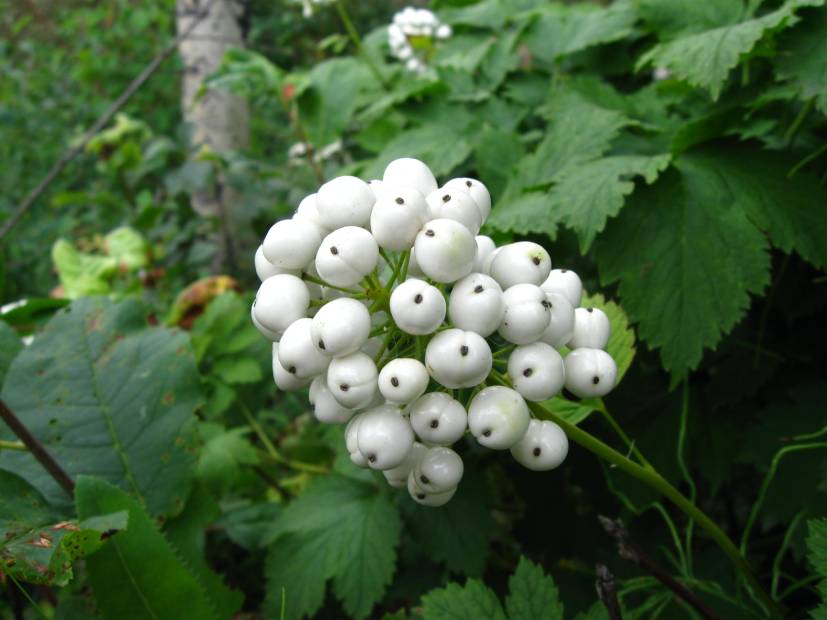
| Scientific Name: | Actaea pachypoda |
| Flower Color: | White |
| Hardiness Zone: | 3 to 8 |
| Bloom Time: | Early spring to early summer |
White baneberry is a herbaceous perennial native to Eastern North America that grows three feet tall and 24 inches wide during maturity. It dies back to the crown during winter and regrows from the base every spring.
The wildflower features serrated compound leaves that remain green throughout the year. Above the foliage grows clusters of fluffy, white flowers supported by red stems. These bloom from early spring to early summer and attract birds and bees.
Eventually, the flowers give way to white berries with beautiful purple doll eyes that extend the plant’s beauty through the summer until fall. Although ornamental, the berries are poisonous to humans and animals—save for certain species of birds that help spread the seeds.
Habitat
White baneberry grows naturally in forests, woodlands, and ravines. It will do well in partial shade to full shade and evenly moist rich soil. However, it will not tolerate standing water.
White baneberries are easy to care for. Ensure you keep the soil moist but well-drained. The wildflower is perfect for your shade garden since it thrives in shade. But you can also plant it in your borders and beds.
5. Indian Paintbrush
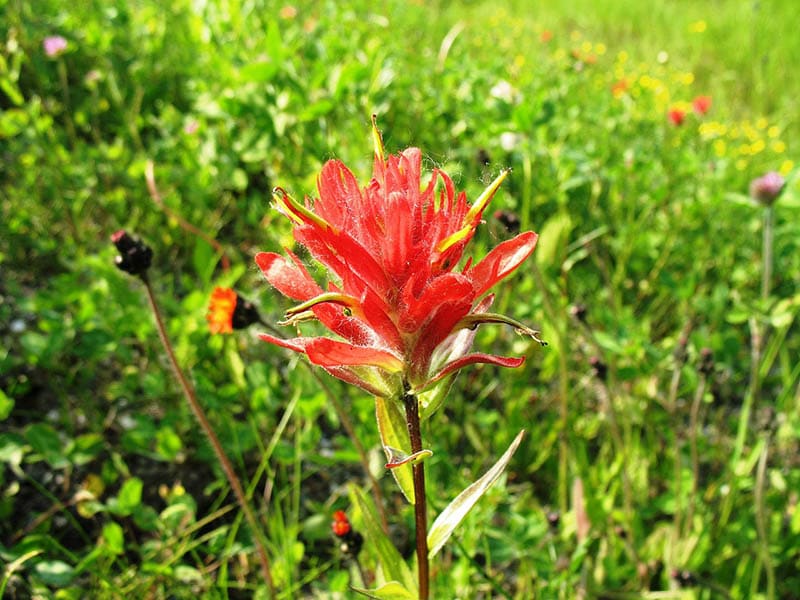
| Scientific Name: | Castilleja coccinea |
| Flower Color: | Yellowish-green |
| Hardiness Zone: | 4 to 8 |
| Bloom Time: | Spring |
Indian paintbrush is a biennial wildflower native to Canada and Eastern North America. It features yellowish-green flowers surrounded by red fan-shaped bracts (modified leaves). According to legend, native Indians used it as a love charm and poison, hence the name.
Indian paintbrush is a hemiparasite flowering plant. That means it gets its nutrients by feeding on other plants. It will attach its roots to the roots of plants such as sagebrush and grasses to collect nutrients.
Habitat
Indian paintbrush naturally occurs in thickets, open woodland, prairies, hills, and dry plains. You will find it growing alongside other plants, such as sagebrush, owing to its hemiparasitic nature.
Although it can tolerate partial shade, the flowering plant flourishes in full sun. It thrives in medium moisture and well-drained soils.
Indian paintbrushes are hard to grow in the garden but not impossible. You must ensure you include host plants alongside it, preferably those that share the same habitat with the plant.
6. Indigo Bush
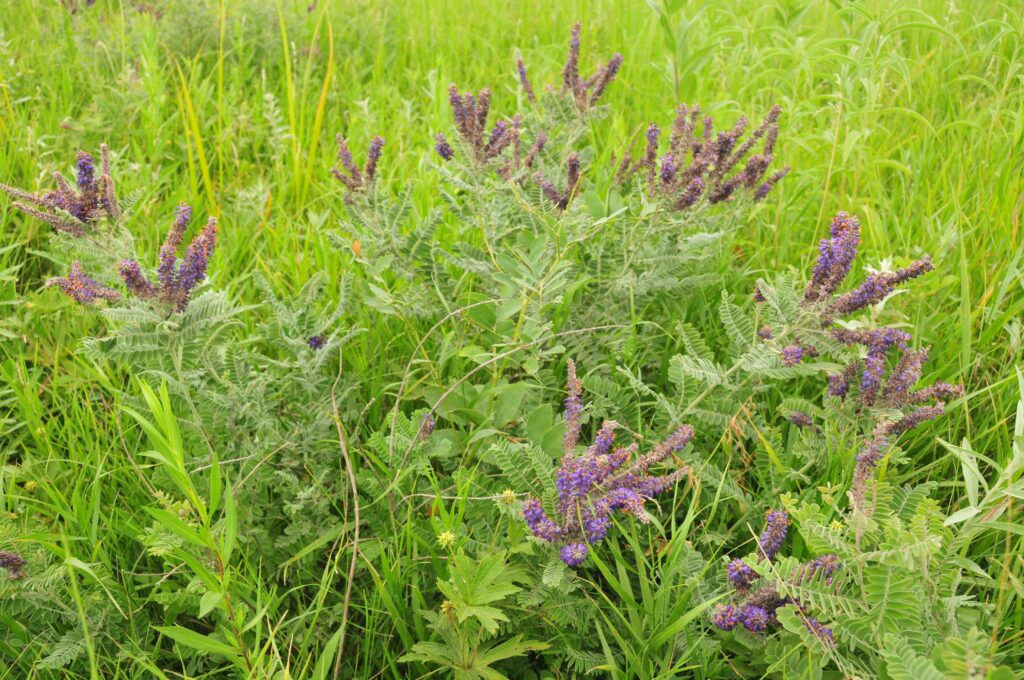
| Scientific Name: | Amorpha fruticosa |
| Flower Color: | Dark blue |
| Hardiness Zone: | 4 to 9 |
| Bloom Time: | Late spring to early summer |
Indigo bush is a shrub native to North America and is classified as a noxious weed in some states. It spreads through seeds and suckers, forming dense thickets. The thickets can grow as high as 10 feet tall and feature alternate compound leaves with spiny tips.
The plant includes several spike-like clusters of dense flowers branching from the stem. Each flower has a single petal, which is dark blue to purple, with yellow stamens extending above the petals.
Habitat
Indigo bush appears as thickets along roadsides, ponds, rivers, and streams. It does well in full sun or partial shade and thrives in acidic, moist, and well-drained soils. However, it will tolerate sandy, dry soils.
You can plant indigo bushes in your borders, beds, meadows, prairies, and wildflower gardens. Additionally, you can also use them for erosion control along slopes and banks.
7. Chicory
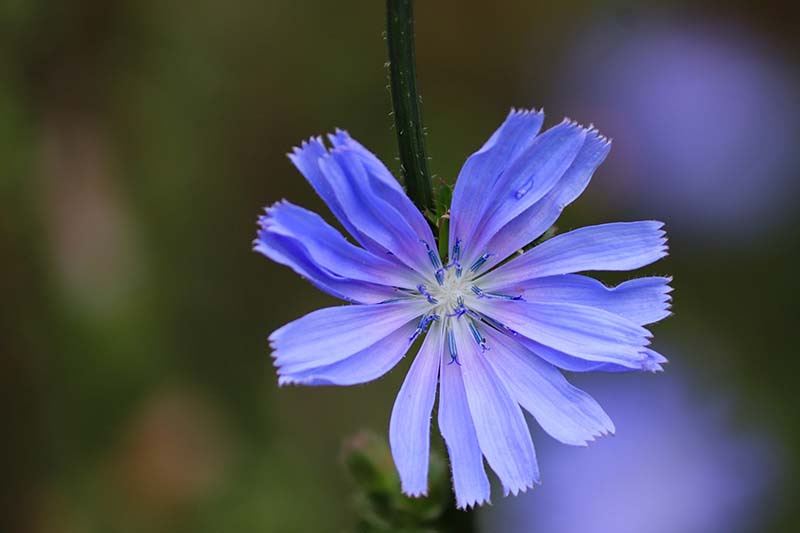
| Scientific Name: | Cichorium intybus |
| Flower Color: | Violet blue |
| Hardiness Zone: | 3 to 10 |
| Bloom Time: | Summer/fall |
Chicory is a perennial herb native to the eastern Mediterranean area. It features stiff and hairy stems with sparsely spaced serrated leaves, which become larger and fuller the lower you go.
Flowers on the chicory plant bloom during summer and fall. Interestingly, their heads open before sunrise and close in the afternoon. Moreover, their color ranges from light to dark blue depending on the level of sun exposure, starting out as dark blue and lightening as the day goes by.
Chicory leaves and roots have been used for food as far back as ancient Egypt. Today, you can include the leaves in your salad since they are rich in minerals and vitamins. The roots also have a high insulin content and can act as a substitute for coffee.
Habitat
You will find chicory growing in the most unlikely places: roadside fields, vacant lots, abandoned pastures, and sidewalk cracks. It flourishes best with full sun, but it can tolerate some shade. The soil should be moist and well-drained, and the pH should range between 5.5 to 7.
Chicory probably doesn’t belong in your ornamental garden since the leaves and stems are a letdown. However, it would look great among your edibles in your kitchen garden.
8. Common Milkweed
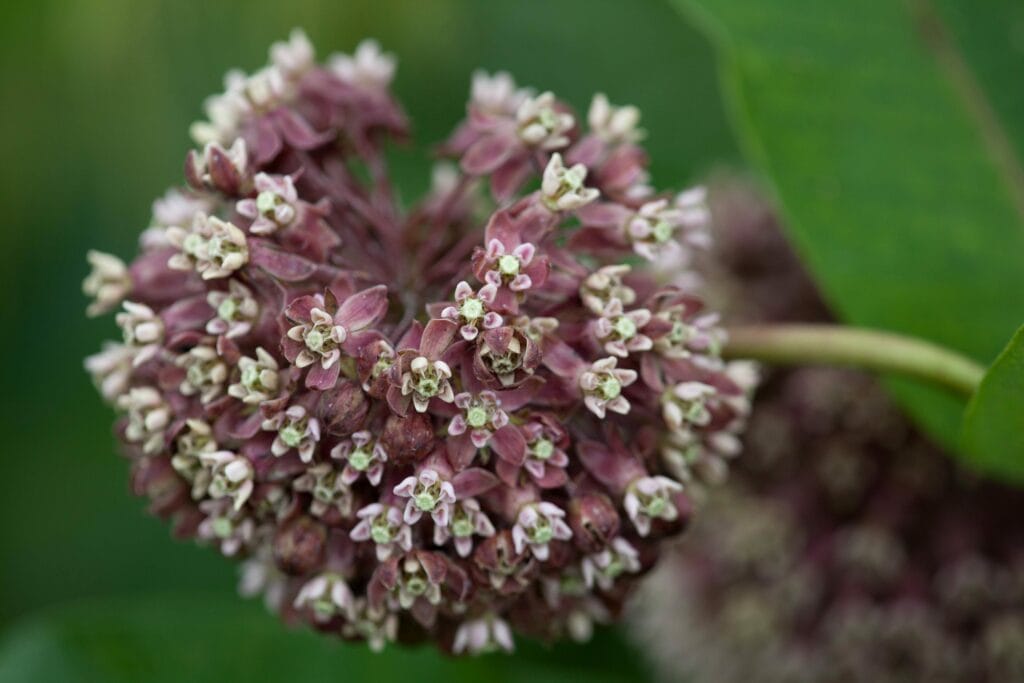
| Scientific Name: | Asclepias syriaca |
| Flower Color: | Pinkish-purple |
| Hardiness Zone: | 3 to 9 |
| Bloom Time: | Summer |
Common milkweed gets its name from the milky white sap it secretes when you break the leaves or stems. The plant features oval dark green leaves with clusters of tiny pinkish purple flowers that bloom during summer. Each flower contains five petals with hoods and horns of equal length.
Common milkweed provides food and habitat for many insects. Over 450 different species feed on the nectar, sap, flowers, and leaves. So, if you want to attract butterflies to your garden, the plant is a must-have.
Several parts of the common milkweed plant are also safe for humans to eat. However, the milky white sap is poisonous.
Mature common milkweed can grow to a height of up to eight feet. But it can be quite aggressive in its ability to spread to the point of pushing out other plants in the ecosystem. In fact, the plant is considered an invasive weed in some states. So, you should consider the potential impact in your area before planting.
Habitat
In the wild, common milkweed will grow just about anywhere. You will find it in roadside ditches, forest clearings, and abandoned fields.
The fragrant wildflower thrives in full sun. Although it performs better in well-drained soils, it can survive in any type of soil, including sandy, loamy, or clay. The soil need not be fertile either.

Final Thoughts
Are you looking to transform the look of your garden, flower bed, meadow, or prairie? You can never go wrong with the wildflowers we listed above. These varieties are adapted for weather conditions in Massachusetts and will survive regardless of what mother nature throws at them.
Featured Image Credit: JumpStory
Contents
